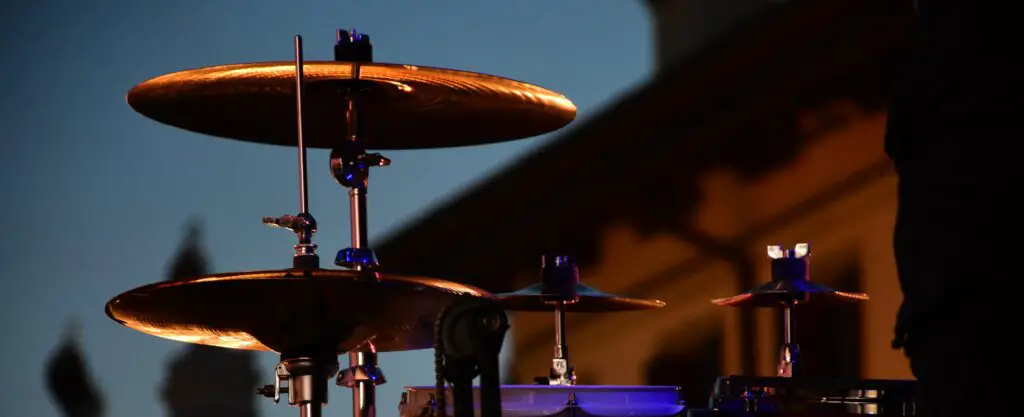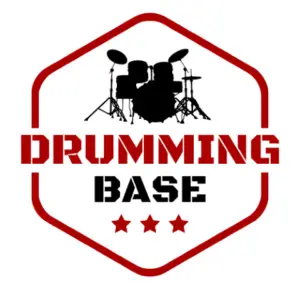If you’re looking to get some new cymbals, one of the first things you’ll need to decide is whether you want a dark or bright cymbal. Most manufacturers will describe the cymbal as either bright, balanced or dark, but what does this actually mean?
In this article I’ll be explaining the difference between dark and bright cymbals and their pros and cons.
Dark vs Bright Cymbals 101
Bright cymbals have a higher pitch and cut through the mix more compared to dark cymbals which sound more mellow. Brighter cymbals are typically smaller, thicker and have a polished finish. Dark cymbals are often used for jazz and R&B whereas bright cymbals are often used for rock, pop and metal.
Check out this YouTube video to hear the difference between a dark (left) and bright (right) crash cymbal.
Bright Cymbals
Bright cymbals have a higher pitch and cut through the mix more easily. In appearance, bright cymbals are polished so have a shiny, reflective appearance and are usually smaller and thicker. Bright cymbals tend to fade quickly and are described as sharp and responsive.
Bright cymbals are most commonly used for:
- Rock
- Metal
- Pop
Zildjian 17″ A Custom Crash (image links to Amazon)
Dark Cymbals
Dark cymbals sound mellow and have a lower pitch which causes them to blend in more with other instruments and sound less harsh. They are often described as sounding more complex in comparison to bright cymbals. Darker cymbals are typically not polished and have a larger diameter and thicker construction.
Dark cymbals are most commonly used for:
- Jazz
- Blues
- R&B
Zildjian 16″ K Custom Dark Crash (image links to Amazon)
Why are Some Cymbals Darker/ Brighter than Others?
The brightness or darkness of a cymbal is affected by several physical characteristics including:
- Diameter
- Thickness
- Finish
- Profile
- Material
Diameter
If a cymbal has a larger diameter but the same thickness compared to another cymbal then it will sound darker because the larger diameter makes the cymbal have a lower pitch.
Thickness
Thicker cymbals sound brighter compared to thinner cymbals due to their higher pitch. Hence, thinner cymbals are typically darker assuming all other variables are kept the same.
Looking for more info on cymbal size and how it affects the sound? Check out my cymbal size guide to learn more.
Finish
There are several types of finish to consider here:
- Brilliant/ Polished Cymbals: these sound the brightest.
- Lathed: these produce a more balanced sound which is darker in comparison to polished cymbals.
- Unlathed/ Unfinished: these cymbals sound very dry and dark.
Images link to Amazon
Profile
The profile/ taper refers to the change in thickness from the bell to the edge of the cymbal. Cymbals with a flatter profile sound darker compared to cymbals with a higher profile.
Material/ Alloy
Cymbals are made from a mixture of copper and another metal to make what’s referred to as an alloy.
The most common metal that is mixed with copper to make the alloy is tin which produces a bronze alloy. The higher the percentage of tin in the alloy, the darker the cymbal sounds.
The most common alloys are B20 Bronze and B8 Bronze:
- B20 Bronze: this alloy consists of 20% tin and 80% copper and sound darker.
- B8 Bronze: this alloy consists of 8% tin and 92% copper and sound brighter.

Music Style Suitability
One of the most common questions drummers ask is whether dark or bright cymbals are more suitable for their style of music. Here’s a quick overview of the types of cymbals commonly used for different genres.
Metal
Brighter cymbals are more commonly used for metal compared to darker cymbals. This is because a harsher, higher pitched sound is required to cut through the other instruments in the band more. A darker cymbal risks blending in too much.
Jazz
Darker cymbals are used more frequently for jazz compared to brighter cymbals. This is because darker cymbals sound more mellow and less brash and blend into the music more. A brighter cymbal often sounds too dominating and aggressive for jazz.
Rock
Bright cymbals are used more commonly in rock music. Bright cymbals are capable of cutting through more which is an advantage when it comes to rock music as otherwise the cymbal risks being drowned out by the other instruments.
Pop
Bright or dark cymbals can be used for pop music depending on the vibe. Bright cymbals are used more frequently for upbeat pop songs whereas dark cymbals may be used if the song has a more relaxed or moody feel.
R&B/ Hip-Hop
Darker cymbals are mainly used for R&B and Hip-Hop. This is because they fit the more mellow tones and bright cymbals otherwise sound to harsh and brash for these styles of music.
Choose the Cymbals YOU Like the Sound Of
Although you’ll typically find bright and dark cymbals being used for specific music styles, in reality, it is really just down to personal preference.
It’s your drum kit at the end of the day and if you prefer to the sound of a dark/ bright cymbal then you should use it! Remember you can also find cymbals which sound more balanced, you don’t have to go for an extremely bright or dark cymbal.
You can also mix and match dark and bright cymbals in your kit. For example you may prefer a dark ride cymbal and a bright crash cymbal.
What are Dry Cymbals?
Dry cymbals have very little wash and less ring to them. This is because dry cymbals do not have a lot of overtones. A cymbal can be bright and dry, or dark and dry, but the most common type is a dark and dry cymbal.
Here are some more articles that you might find useful:






